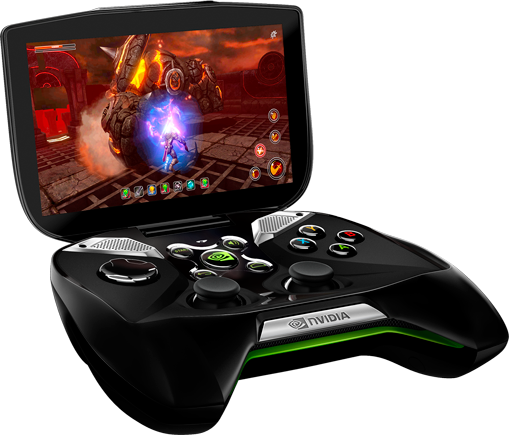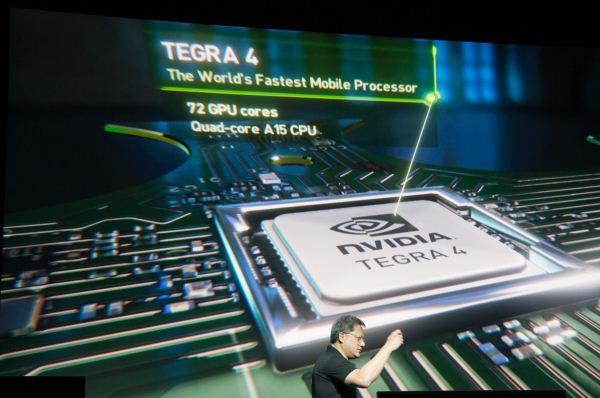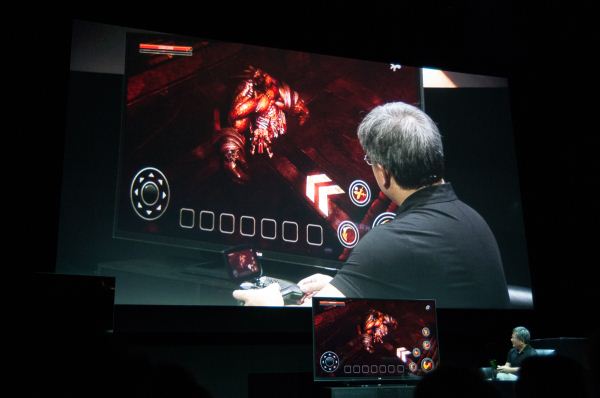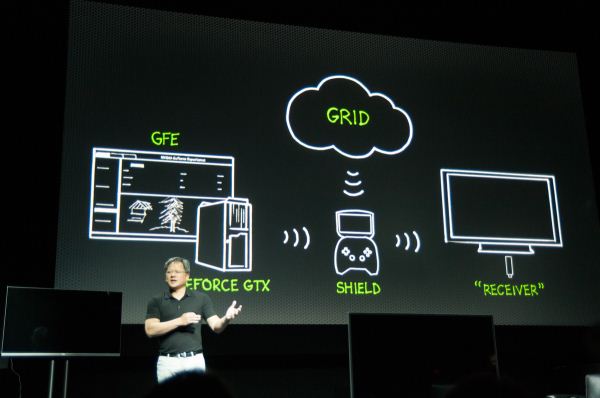NVIDIA Rolls Their Own Handheld Console: Project Shield, Powered By Tegra 4
by Ryan Smith on January 7, 2013 1:14 AM ESTNVIDIA Rolls Their Own Handheld Console: Project Shield, Powered By Tegra 4
Though most of the important launch details of Tegra 4 were leaked weeks in advance, NVIDIA did manage to keep their final major CES announcement under wraps to the very end. Wrapping up their CES presentation, NVIDIA has announced that they will be entering into the handheld console business with their own Tegra 4 powered console, dubbed Project Shield.

While we’re still waiting on NVIDIA for further details, what we do know so far is that Project Shield is essentially a handheld console built around NVIDIA’s recently announced Tegra 4 SoC. Details on Tegra 4 are still sparse since NVIDIA has not announced the individual SKUs, but we do know that the top-end configuration contains 5 ARM A15 CPU cores in a 4+1 configuration similar to Tegra 3, and on the GPU side is backed with a hereto unknown GPU architecture composed of 72 GPU cores.
All of this is built into an oversized game controller that is configured very similarly to the PS3 DualShock 3 controller, possessing 2 concave thumbsticks, a 360-like D-pad , 4 face buttons, and 4 shoulder triggers/buttons (2 on each side). Topping off the console is a 5” 720p multitouch display (no word yet on whether it’s OLED or LCD) that flips over the console in a clamshell fashion. Meanwhile powering the device will be 38 watt-hours of Lithium-Ion battery cells; this is roughly between the Nexus 10 (33.75Wh) and the iPad 3/4 (42.5Wh), meaning Shield will have what amounts to a tablet-capacity battery.
Backing that hardware, storage is provided by a combination of internal and external storage; external storage is provided by a micro-SD card slot found on the back side of the handheld. Also found on the back side of the handheld are a number of other ports: micro-HDMI for display output (4K resolution supported!), micro-USB for data connectivity, and a standard 3.5mm audio jack for headphones. Wireless connectivity is also available, with WiFi for data and Miracast plus additional formats for video output.
On the software side of things Project Shield is running what NVIDIA is calling “pure Android”, which in this case is presumably a reference to them not doing any skinning/customizations, ala MotoBlur, TouchWiz, and other OEM customizations. This means that Project Shield is capable of running standard applications (something NVIDIA made sure to demo) and is otherwise usable as a standard Android device. Meanwhile NVIDIA’s Shield application is where gaming takes place, effectively launching users into NVIDIA’s own sandbox, where gamers can pick up Shield-optimized games from the TegraZone store and then run them on the device.
Finally, on the software side of things NVIDIA is also going to be offering a level of integration between Project Shield and their GeForce products by offering their own Splashtop-like remote gaming experience. By leveraging the Video Codec Engine video encoder inside their recent GTX 600 video cards, Project Shield devices will be able to connect to PCs to do remote gaming. To show this off NVIDIA showed a GTX 680 equipped PC running Steam in Big Picture mode being streamed to Shield, the logical pairing to Project Shield’s dual nature as a portable computing device and a controller. Shield will of course also be able to function as an endpoint for any cloud game service providers using NVIDIA's GeForce GRID technology.
Edit: At this point NVIDIA has not announced hard pricing or availability, but we have been given guidance that "Shield will launch in Q2 at a price competitive with other mobile gaming systems and tablets." Since the critical component here is Tegra 4, the Q2 projection for Project Shield’s availability most likely hinges on when exactly T4 will become available this year.
| Handheld Specification Comparison | ||||||||
| Project Shield | Sony PS Vita | Nintendo 3DS XL | Google Nexus 7 | Apple iPad mini | ||||
| Display | 5-inch 1280 x 720 | 5-inch 960 x 544 OLED | 4.9-inch 800 x 240 + 4.2-inch 320x240 TN | 7" 1280 x 800 IPS | 7.85-inch 1024 x 768 IPS | |||
| CPU | NVIDIA Tegra 4 (4+1 Cortex A15) |
4 x Cortex A9 |
2 x ARM11 |
1.3 GHz NVIDIA Tegra 3 (T30L - 4 x Cortex A9) | 1GHz Apple A5 (2 x Cortex A9) | |||
| GPU | NVIDIA Tegra 4 (72 GPU cores) | PowerVR SGX543MP4 | PICA 200 | NVIDIA Tegra 3 (T30L) | PowerVR SGX543MP2 | |||
| Connectivity | WiFi, HDMI, USB | WiFi, USB | WiFi | WiFi , USB | WiFi, Lightning | |||
| Memory | N/A | 512MB + 128MB | 128MB + 6MB | 1GB | 512MB | |||
| Storage | N/A + Micro-SD | Proprietary | 2GB + Micro-SD | 16GB | 16GB | |||
| Battery | 38Wh | 8.2Wh | 6.5Wh | 16Wh | 16.3Wh | |||
| Starting Price | N/A | $249 | $199 | $199 | $329 | |||
Source: NVIDIA Project Shield Page



















26 Comments
View All Comments
Guspaz - Monday, January 7, 2013 - link
Let's not also forget that one of the big reasons that the PSPGo failed was due to the limited software library, high-priced games (UMD versions of games would get cheaper over time as retailers discounted older stock and had sales, download versions often ended up more expensive than the UMD versions), and the inability to use your existing PSP game library (Sony cancelled the UMD-to-download conversion program).This console would seem to avoid many of these problems right off the bat. It's focusing on Android games, and mobile games are already fitting into a much lower price range (even Squenix's extremely expensive mobile games are a fraction the price of a PSP game), and it will let you bring your existing Android game library with you, assuming you're an Android user.
If they do intend to make a serious go at the mobile gaming console market, though, that would make them the only mobile console manufacturer who doesn't have any first-party games. That means that if they want any console-defining games (the kind that sell consoles), they'll have to pay some other developer for exclusivity to do it, and that kind of thing wouldn't be cheap.
CeriseCogburn - Monday, January 14, 2013 - link
nVidia is known for years of close relations and working with developers. LOLIf this was AMD, we'd have problems and they could brag they use "email a lot", which they have.
nVidia has 200+ engineers worldwide at developers all the time, amd "a handful", literally.
nVidia has billions in the bank, amd billions in debt.
Beyond that, this streams your PC games to the device - now I can be in the workshop, on the couch, waiting for lunch in the kitchen, outside in the yard grilling, you name it, and I've got all my PC games at my fingertips, with STEAM working as well....
This thing is GREAT - I already want one. The sound is awesome, the lag is non existent, those who've had hands on are very positive.
Touchscreen, websurfing, tegrazone games, home PC streaming - LOL it's about time.
TOUCHSCREEN - everything but a phone... awesome.
labrats5 - Monday, January 7, 2013 - link
This doesn't look like a product intended to be successful, but rather one designed to be talked about. This is the sort of product that will only appeal to very few people, but as a promotional tool for the Tegra 4 and the nvidia brand in general, they've guaranteed that every tech site will be talking about them for weeks and months to come. Hopefully this will translate into better brand awareness and positive brand association. Nvidia has been trying hard to make the Tegra brand one that geeks ask for by name and recommend to their friends and family. This is just seems like one more step in that plan.CeriseCogburn - Monday, January 14, 2013 - link
It appeals to you.http://www.youtube.com/watch?v=gxsNhySj1Ng
There's nothing to not like.
ET - Monday, January 7, 2013 - link
I noticed this wrong piece of info in the table.Regarding this console, I think it hits a lot of right notes, and it looks like the Tegra 4 may be around the power of current gen consoles, so there's a chance it could be a good console even without PC streaming. NVIDIA is good at working with developers, and I'm sure we'll see Tegra 4 specific titles, and titles taking full advantage of the Shield's controller.
Guspaz - Monday, January 7, 2013 - link
The big question is the GPU. Tegra has always been decent in the CPU department, but a laughable joke (compared to the competition) in the GPU department. That has remained true for all three revisions of the product, always falling way behind the competition (ironic for a GPU company).The real question about the Tegra 4 is going to be if they finally resolved the GPU performance issues. Tegra 3 currently benchmarks at 20-25% the performance of a PowerVR SGX554MP4, the fastest chip currently on the market. nVidia is claiming a 6x boost in performance, which would seem to put them, based on their claims, at 120-150% the performance of the current top performer. However, consider that such benchmarks (the "X times faster" from the manufacturer) and that the Tegra 4 isn't actually out yet (as in the other GPU vendors won't be standing still between now and then)...
The answer to the question of "Has nVidia finally produced a mobile GPU that has competitive performance" seems to be "possibly". Their target performance seems to say it would be competitive. Of course, the Tegra chips have always been sub-optimal in terms of power usage, so if all they've done is tweaked their existing GPU core and multiplied the core count by six, power usage might not be competitive.
CeriseCogburn - Monday, January 14, 2013 - link
There's no question anymore, people have had hands on. Leaks are a coming.http://www.chiphell.com/thread-616838-1-1.html
This in nvidia, not some constant failure company like amd.
Tegra3 took on Apple's exclusive powerVR and matched it and often beat it in gaming, so blabbing about opengl render or some crap is useless, and 20-25 percent is a lie anyway. spin spin spin spin
Real life: " In actual life terms, Nvidia says it'll be the difference between two seconds of rendering on the iPhone and 0.2 seconds on a Tegra 4-powered mobile camera. "
The chart here shows it beating ipad4 25 webpages load not by much - I'm not impressed by that..
http://gizmodo.com/5973635/the-tegra-4-is-here?tag...
That's the worst news I could find on it.
maximumGPU - Monday, January 7, 2013 - link
Wish we could have it as a handheld WITHOUT the screen, so we could utilise its streaming capability without the added cost of a screen some of us won't find a good use for..Death666Angel - Monday, January 7, 2013 - link
There will be enough USB-stick Android devices with Tegra 4 out there for that purpose. :)For me, this is interesting as a novelty thing, but looks too big as a portable (7" tablet with bluetooth gamepad might be just as functional and cheaper or more versatile) and I am not that interested in Android games that need a controller on the go. As an at home console, sure, but I already have my tablet with mini-HDMI out for that.
Still, more products can't hurt. :)
MonkeyPaw - Monday, January 7, 2013 - link
That's a mighty big battery in that thing. Makes me wonder just how efficient that SOC really is, or if maybe it's a high performance version that you won't see in ordinary tablets.